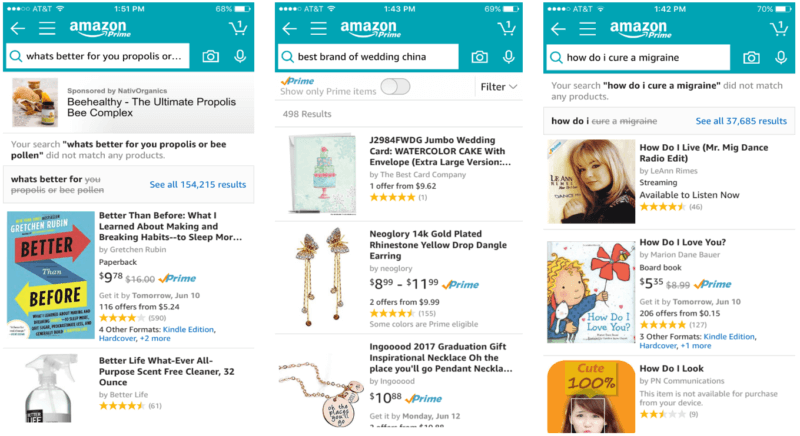No matter where they’re located or what market they serve, retailers around the globe have questions about how consumers use search and Amazon.
At Bing (my employer), we’ve found that retailers — regardless of size — ask us about the same three things:
- Where do consumers look for products online?
- How do users behave differently on search vs. Amazon?
- Can my search and Amazon channels benefit each other?
The answers are likely to surprise you.
The consumer decision journey looks incredibly complicated to us marketers with its interweaving between research, comparison, intent and transaction, but it feels far less complicated from the consumer point of view.
As consumers, we follow certain behavior patterns almost subconsciously:
- If we have questions around what it is we need, or want more information before we make a selection, then it’s natural to turn to search.
- If we know what we’re looking to buy, often we have a predefined preference for which retailer website to begin looking for it.
For many customers, Amazon is a place to start. But is it where customers do most of their shopping-related searches? And is it also the place that they end their journey?
Our company’s search market intelligence team sought to find out.
1. Where do consumers look for products online?
The goal of the test was to study how consumers shopped online, and to learn how search and Amazon fit in within the customer decision journey.
Testing methodology
- We used a sample of 9 million US users who conducted a retail-related search or visited Amazon on a web browser.
- We tracked the user activity on Amazon and Bing and categorized users in different retail categories based on their searches.
- We tracked the user journey, from searching on our site to visiting and searching on Amazon, and vice versa, to understand patterns around user groups that come back to the search engine.
- We scaled the analysis using comScore data to be representative of mobile and app usage.
The myth
“The majority of retail searches now happen on Amazon.”
This myth has been repeated so many times, it’s often taken as fact just from repetition. It is likely derived from studies that report 56 percent of consumers begin their shopping journey on Amazon. The issue lies in the fact that this number is getting misinterpreted as 55 percent of overall retail searches happen on Amazon — which isn’t true.
The thing to remember is that survey data, while extremely valuable, may not always tell you the full story. Often, the decisions we make are formed by unconscious biases or are very generalized, so we can’t speak to our actions with a 100 percent degree of accuracy.
Think about this: If you’ve ever started your product search on Amazon, does that mean that you would always turn to Amazon to start your search for every single product? Or that you don’t conduct any searches after Amazon?
We know conceptually that is not true, so the researchers used behavioral data to answer that question.
The reality
The reality is, we turn to Amazon for only certain types of searches, mainly the lower-funnel ones. But those are only a small fraction of the overall universe of retail searches — nowhere near the 55 percent that is often cited.
For example, think of queries like “best brand of wedding china,” “how do I cure a migraine” or “what’s better for you propolis or bee pollen.” Would your natural instinct for those queries be to turn to a search engine or to Amazon?
More than likely, your answer would be the former, since at the moment, the latter isn’t really built to answer these questions. Case in point:

Search, on the other hand, is used for queries that span the entire range of the funnel, and that’s where logic would dictate the majority of retail searches occur.
The research agrees.
The results
In reviewing millions of users across our data set and comScore’s panel, the team’s research found that most retail searches don’t happen on Amazon; instead, 70 percent of them happen on top search engines.

A study conducted by Rand Fishkin at Moz earlier this year, which analyzed clickstream data via Jumpshot, came to a similar conclusion. Fishkin asked Jumpshot to compare 10 distinct web properties, add together all the searches they receive combined, and share the percent distribution.
The data found that Amazon received only 1.85 percent of searches, whereas Bing, Yahoo and Google combined received 64.02 percent of searches.
What does that mean for marketers?
Amazon is a strong retail channel and continues to grow, though marketers should be careful not to overcorrect. Search not only stands strong as a retail channel, but it can also help complement and strengthen an Amazon strategy as well.
2. How do users behave differently on search vs. Amazon?
In looking to identify how user behavior differed across search and Amazon, we found that 27 percent of users (about 38 million people in the US) did not visit Amazon either before or after searching on Bing.
These are valuable audiences that are looking for your product information online and buying them in physical stores or other online channels.
Even more interestingly, the research found that even the audiences that were common between search and Amazon exhibited different behaviors across each platform.
Testing methodology
Exclusive Audience using our search engine:
- We collected data from Nov 1-7, 2016, using Web Browser Logs (US only).
- We tracked the user activity on Amazon and Bing and categorized users based on queries searched.
- We filtered for users that do retail-related searches on a search engine (combination of various categories such as: Autos; Guns; Sports & Recreation; Office Products; Health & Wellness; Beauty & Fragrance; Clothing & Shoes; Jewelry & Watches; Home Furnishings; Kitchen & Housewares) and computed exclusivity of these search users that don’t visit Amazon.
- We scaled the users to overall population based on comScore’s panel.
- Similar distributions of overall exclusive users were found on larger time periods (~1.5-2 months).
Some opinions expressed in this article may be those of a guest author and not necessarily Marketing Land. Staff authors are listed here.
Popular Stories
Facebook yanks education, employment, field of study and job title targeting after advertiser selects ‘Jew hater’ and ‘NaziParty’ 100+ Questions You Must Ask When Developing A Website Facebook tests a new ad format that puts it further ahead of its competitors Why Social Media Advertising Is Set To Explode In The Next 3 Years
Read the original article here


